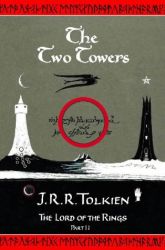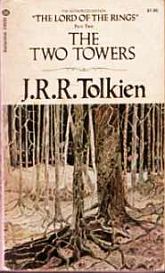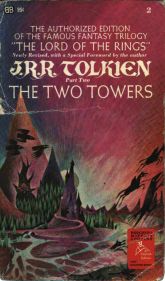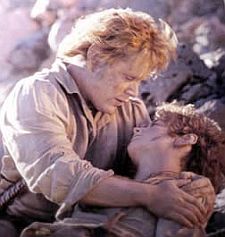Many people who read The Lord of the Rings falter somewhere in The Two Towers, and that’s perfectly understandable. According to J.R.R. Tolkien’s Foreword to the Second Edition of LOTR, he actually faltered in the writing of it, putting the book down for two years before picking up again in book 4. (“Foresight had failed and I had no time for thought,” says J.R.R.)
 It’s a difficult book. Frodo and Sam, the characters we’re most invested in, disappear for a couple hundred pages; Gandalf is presumably dead in the book’s opening chapters; Boromir’s definitely dead; and Aragorn is still something of a distant figure. Gimli is interesting enough but hardly crucial to the plot, and it’s difficult to give two figs about Legolas.
It’s a difficult book. Frodo and Sam, the characters we’re most invested in, disappear for a couple hundred pages; Gandalf is presumably dead in the book’s opening chapters; Boromir’s definitely dead; and Aragorn is still something of a distant figure. Gimli is interesting enough but hardly crucial to the plot, and it’s difficult to give two figs about Legolas.
Then we have the problem of the Rohirrim. As far as I’m concerned, Tolkien doesn’t do a very good job getting the audience to buy in to the kingdom of Rohan. I was shocked to discover that Éowyn is given less than a page in Two Towers, barely enough time for her to show up and cast eyes lovingly at Aragorn. Erkenbrand, Háma, and Gamling are just tertiary characters, nobody we particularly care about. The only person who really grabs your attention in these opening chapters about the Riddermark is Éomer. Before we’ve formed any emotional attachment to Rohan, Théoden’s off to Helm’s Deep.
As for Théoden? Théoden becomes more likable as the book goes on, and he really comes into his own when he rejects Saruman’s offer of peace at Orthanc. But when we first see him, the king of Rohan is just a cranky old man under the sway of bad counsel. Then Gandalf shows up, speaks a few strong words, casts Wormtongue down on his belly — and Théoden has a baffling change of heart. In my LOTR omnibus edition, we first meet Théoden on page 501; Gandalf casts Wormtongue down on page 503; on page 507, the king’s already mustering the troops. Too quick.
Now Gandalf is supposed to be a Maiar of old, and it’s said somewhere that his “magic” is to inspire the people of Middle Earth. To restore them to their youth and vigor, to rekindle the divine spark within. So that could certainly explain Théoden’s sudden shift. But then why didn’t Gandalf accomplish the same thing the last time he saw the king? Okay, there’s a convenient excuse — Gandalf was in a big hurry. But Gandalf’s obviously been in and out of this place many times, and Saruman’s poisoning took years.
So Théoden’s conversion is somewhat puzzling and the Rohirrim are still strangers. Therefore I wasn’t particularly invested in the battle of Helm’s Deep. The battle itself is the first extended battle sequence Tolkien had written since the Battle of Five Armies in The Hobbit, and it’s considerably better done than that. But Peter Jackson’s instincts were correct in trying to build up this battle with every scrap of back story he could find. I struggled hard to care about anyone here but Aragorn, Legolas, and Gimli.
But I want to come back to Théoden’s choice to cast aside Gríma Wormtongue and follow the advice of Gandalf, because such choices are what this book is made of. Everyone gets their moment of choice in Two Towers.
Sam and Frodo stand on the brink of Mordor and decide to press on, even if nobody is left alive to know about it. Saruman is given a clear choice by Gandalf to come down from Orthanc and walk the long, hard road towards forgiveness, or to rot in his tower. Treebeard and the ents must decide whether to confront Saruman or to sit back and await “the withering of all woods.” Even Gollum has a moment standing over the sleeping bodies of Sam and Frodo on the stairs of Cirith Ungol where he briefly reconsiders his evil plot to lead the hobbits to Shelob.
So what are our characters choosing between? For Tolkien, the choice is not complex: there’s light, and then there’s darkness.
 White light is the purest representation of the holiness of the Valar –the White Tree of Gondor, the white light of the Silmarils, the white light of Galadriel’s phial, Gandalf’s reincarnation as the White Wizard. Meanwhile, black is the symbolic color of Sauron and evil. Black is darkness, black is the skin color of the “cruel Haradrim,” black is the color of the Nazgûl, the Black Riders. (About the racial aspect of Tolkien’s writing, see my post on The Silmarillion.)
White light is the purest representation of the holiness of the Valar –the White Tree of Gondor, the white light of the Silmarils, the white light of Galadriel’s phial, Gandalf’s reincarnation as the White Wizard. Meanwhile, black is the symbolic color of Sauron and evil. Black is darkness, black is the skin color of the “cruel Haradrim,” black is the color of the Nazgûl, the Black Riders. (About the racial aspect of Tolkien’s writing, see my post on The Silmarillion.)
And in Tolkien’s world, the bad guys are always trying to muddy the distinction between black and white, thereby muddying the distinction between the moral decisions the characters must make. Remember how Saruman rejects the designation of white, as Gandalf recounts during the Council of Elrond in Fellowship of the Ring:
‘I looked then and saw that his robes, which had seemed white, were not so, but were woven of all colours, and if he moved they shimmered and changed hue so that the eye was bewildered.
‘ “I liked white better,” I said.
‘ “White!” he sneered. “It serves as a beginning. White cloth may be dyed. The white page can be overwritten; and the white light can be broken.”
‘ “In which case it is no longer white,” said I. “And he that breaks a thing to find out what it is has left the path of wisdom.”
So The Two Towers is a book where all of the players must figure out what’s the right path and what’s the wrong path and what’s simply the convenient path. For Frodo and Sam, choosing the right path is a very literal thing. They spend most of the book teetering on the brink between Mordor and Gondor, and until the Stairs of Cirith Ungol, the path westward to Gondor is always the closer and easier route. Likewise, Rohan could have accepted Saruman’s offers of alliance; the ents could have sat the war out and left it to the Elves and Men; Frodo could have had Faramir’s men kill Gollum at the Forbidden Pool.
(In light of these tough moral choices that fill The Two Towers, the character of Faramir is quite frustrating, and I can completely understand why Peter Jackson decided to give him a makeover in the films. Faramir manages to completely resist the lure of the Ring where even Galadriel could not. “Not even if I found it on the highway would I take it,” he says, bizarrely.)
(As a result, without any real choice to confront, Faramir’s really not much of a character. His purpose in The Two Towers is really to act as a moral foil for Frodo, giving him the opportunity to do away with Gollum, and get an armed escort back to Minas Tirith, if he wants. Faramir also provides a convenient bit of foreshadowing for the confrontation with Shelob. But beyond that, he’s just another one of Tolkien’s pleasant, wise, faceless heroes that just seem to be wandering around Middle Earth, like Gildor, like Glorfindel, like Haldir.)
 So every character is confronted with their moral choice. How to choose among them? For Tolkien, it’s really not a complicated issue. Chase down those moral grays for long enough, and they all eventually resolve into black or white. As Éomer asks Aragorn at one point, “How shall a man judge what to do in such times?” Tolkien’s mouthpiece Aragorn replies:
So every character is confronted with their moral choice. How to choose among them? For Tolkien, it’s really not a complicated issue. Chase down those moral grays for long enough, and they all eventually resolve into black or white. As Éomer asks Aragorn at one point, “How shall a man judge what to do in such times?” Tolkien’s mouthpiece Aragorn replies:
‘As he ever has judged… Good and ill have not changed since yesteryear; nor are they one thing among Elves and Dwarves and another among Men. It is a man’s part to discern them, as much in the Golden Wood as in his own house.’
Many have criticized Tolkien over the years for this simplistic black-and-white approach. They call his villains one-dimensional, they decry his treatment of the orcs as an evil race beyond any possibility of redemption. Sauron is just a faceless cipher.
But such critics are missing the point, I think. The real villains in The Lord of the Rings aren’t the orcs, or the Nazgûl, or even Sauron. The real villains are the temptations within. Despair, greed, pride, anger, fear. Sauron and his minions are just the external manifestation of these things.
And this is part of the genius of Tolkien, and one of the things that makes these books so much more interesting than the simplistic good-vs-evil battle they’re often made out to be. There really are no evil characters in The Lord of the Rings. Sauron? The Witch-King of Angmar? The Balrog? These aren’t characters, per se. We learn very little about their motivations, and they only appear at a remote distance. There’s no reason Sauron wants to conquer Middle Earth; he just does. Sauron is the magnetic pole that pulls our characters towards the Dark Side, while Gandalf (representing the Valar over the sea) is the magnetic pole for the Light.
So the orcs and the trolls and the Nazgûl get short shrift by Tolkien, because they’re not really who he cares about. He cares about all of us down here in the middle, wavering between good and evil, trying to make the difficult choices between them. His “villains” are Boromir, a brave soldier who gives in to temptation; Gollum, a hobbit-like creature who’s in over his head; Wormtongue, a man who’s chosen the most expedient side in a brewing war; and so on. People caught in between the two distant poles of Absolute Good and Absolute Evil, struggling to find a way between them and choose a side.
It’s a very Christian concept. Discern the moral choice; make the right choice, even if it’s the least expedient or most fraught with danger; and have faith that the right will prevail in the end.
*****
An interesting side note:
You may laugh, but I find some very solid gay overtones in the relationship between Sam and Frodo, especially in The Two Towers. Yes, I understand that Tolkien didn’t mean for them to actually be gay, and that the main thing he was exploring here was the master/servant relationship.
 But what to make of Sam attacking Shelob like a “small creature armed with little teeth, alone, will spring upon a tower of horn and hide that stands above its fallen mate”? What to make of Gollum finding Sam and Frodo dozing with their arms around one another and Sam’s head in his lap? What are we to make of Sam, in the midst of preparing rabbit stew for Frodo, studying the lines on his sleeping face and then saying, “I love him. He’s like that, and sometimes it shines through, somehow. But I love him, whether or no”?
But what to make of Sam attacking Shelob like a “small creature armed with little teeth, alone, will spring upon a tower of horn and hide that stands above its fallen mate”? What to make of Gollum finding Sam and Frodo dozing with their arms around one another and Sam’s head in his lap? What are we to make of Sam, in the midst of preparing rabbit stew for Frodo, studying the lines on his sleeping face and then saying, “I love him. He’s like that, and sometimes it shines through, somehow. But I love him, whether or no”?
There are plenty more examples. So scoff if you want, and tell yourself that J.R.R. Tolkien lived in a more innocent time where these things could be written without having any homosexual overtones. But I’m sure that even in Tolkien’s time there were old English bachelors who lived together and puttered in the garden together and finished one another’s sentences, and even J.R.R. wasn’t completely naïve about what was going on.
I’m convinced the overtones are there. Why exactly Tolkien put them there, I’m not sure. Any ideas?
*****
Another side note:
Peter Jackson got a lot of heat from fanboys who felt that Treebeard’s decision to march to war in the film was completely out of character. After a two-day colloquium with all of the ents, he suddenly reverses himself at the sight of a few burnt trees? But on re-reading The Two Towers, I was shocked to discover that Treebeard’s decision to go to war is just as hasty in the book as it is in the film. In a single conversation with Merry and Pippin, Treebeard goes from “I have not troubled about the Great Wars… they mostly concern Elves and Men” (middle of p. 461) to “I have been idle. I have let things slip. It must stop!… I will stop it! And you shall come with me” (top of p. 463).
While I admit that the films are flawed, more and more I’m coming to the conclusion that Peter Jackson and his co-screenwriters read these books very, very carefully and came to many of the right conclusions.